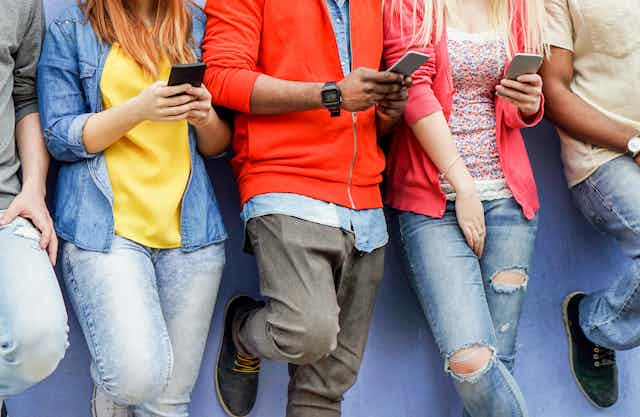There are now more mobile devices than people on the planet. You only have to glance around on trains, in the street, or in cafes to see how increasingly lost we are in screen time. We don’t just hold our phones, we cradle them.
It is ten years since the iPhone’s release to the general public. And so now seems a perfect time to reconsider our love of technology.
I’m fascinated by our relationship with mobile phones, both past and present. Nokia has recently released a new version of the classic Nokia 3310. Originally launched in 2000, it was the company’s most successful phone, selling over 126 million units. This technology nostalgia speaks of simpler times when a phone was a phone, not a computer; when we weren’t tethered to our workplace. A time when we met the gaze of others rather than the ever constant glow of our interactive screens.
Our phones track, trace and archive our lives almost seamlessly. We’re leaving increasingly complex trails of messages, updates and other bits of our life stories online. We have access to a seemingly infinite archive of our emotional pasts.
As I’ve written previously, this is something that I am particularly aware of. One morning I found an old Nokia at the back of a kitchen drawer, and scrolling through its inbox I realised I’d unwittingly archived a three-year text message dialogue between my son’s father and me: a relationship that unfolded in just 100 texts and told the story of how we met, dated for just a few months, broke up and subsequently dealt with an unplanned pregnancy. His last and final text message read: “I’m Moving to Spain.”
I recently bought this story to life in 160 Characters, a smartphone short I filmed and directed for Film London. It is currently playing at Picturehouse Cinemas across London. The film explores the consequences of our access to our past. It aims to capture the challenges and limitations of early digital dialogues, to explore the space between words, the pauses, the moments in which I struggled to compress big emotions into what was then a 160 character message limit.
My own text message thread was just 100 texts, sent over three years. Now, my teenage niece can send 100 texts before lunchtime, on a phone that enables her to share these dialogues with the rest of the world. And so I decided to use my iPhone as a tool to explore the present as well as the past. I shot all the contemporary sequences on my iPhone 6, filming at the London locations where I sent or received the original text thread. Stories and relationships that were originally mediated through mobile phones were bought to life using the latest in smartphone production techniques.

The digital traces we leave behind us create a wealth of data about our lives, an ever evolving archive which creates a map of where we’ve been and where we’re going. Over the last decade many directors and artists have attempted to capture the emotional subtext of mobile phone dialogues, to convert the vernacular of digital dialogues and interactive screens into great drama. When writing a screenplay, once hidden text messages can reveal the secret lives of the central characters.
This has resulted in an evolving genre of films, TV and artworks which reflect our ever changing relationship to technology. The BBC series Sherlock and Charlie Brooker’s Black Mirror are just two obvious examples of the ways in which cinema and TV have been influenced by the aesthetics and affordances of mobile media. The other night I enjoyed two such dramas back to back: BBC drama documentary Theresa vs Boris: How May became PM and Channel 4’s Ackley Bridge, which both featured text dialogues between the central characters.
There are also some interesting and experimental shorts that have evolved from this genre, such as Patrick Cederberg and Walter Woodman’s Noah or Trim Lamda’s Cracked Screen: A Snapchat Story
Our mobile phone has become like a time machine: it connects us with our past, our present and our future. The past is always with us, in the phones we cradle. The digital traces we leave behind us create a wealth of data about our lives, an archive of stories which artists and filmmakers will continue to capture and preserve.
We’re at the dawn of a new genre of technological storytelling which will continue to explore how we can collect, curate and share stories from our digital past. As technology continues to evolve, so too will representations of the increasingly complex ways in which emotions and technology converge.

